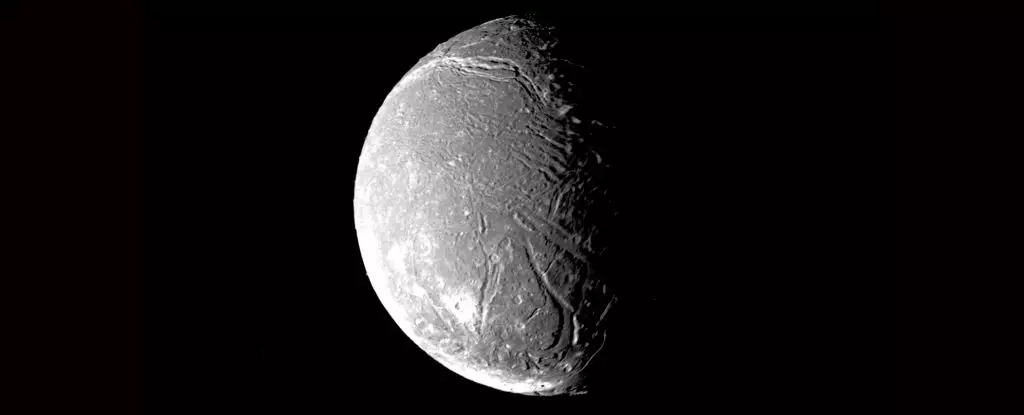The vastness of our Solar System is punctuated by mysteries lurking beneath the icy surfaces of distant moons, particularly those orbiting the gas giants Jupiter, Saturn, Uranus, and Neptune. These celestial bodies are believed to harbor hidden oceans, shielded by thick layers of ice. Among these moons, Ariel, a satellite of Uranus, has recently garnered attention from planetary scientists due to the intriguing characteristics of its surface and the tantalizing possibility of underlying liquid water. This article delves into the scientific findings surrounding Ariel, exploring its geological features and their implications for understanding the moon’s interior and potential ocean.
One of the most striking features of Ariel is its surface, which exhibits deep chasms and grooves that catch the eye of astronomers and planetary geologists alike. Resembling scars on a face, these surface formations suggest dynamic geological processes at play. Notably, Ariel’s chasms are home to carbon dioxide ice and carbon-bearing deposits, hinting at complex chemical activities below the surface. Chloe Beddingfield, a planetary geologist at Johns Hopkins University, emphasizes their importance: “These medial grooves are among the best candidates for sourcing those carbon oxide deposits,” highlighting how they could provide insights into the moon’s hidden layers.
The fascinating aspect of these chasms is their potential link to geological phenomena known on Earth. Specifically, the study suggests parallels with the process of crustal spreading observed at mid-ocean ridges, where tectonic plates shift and new crust material emerges. By employing observational data and formation models, researchers have attempted to decipher the origins of these chasms and the significance of their parallel grooves, which may indicate the historical movement of material from Ariel’s interior.
Understanding how spreading could manifest on Ariel is critical in unraveling the moon’s geological history. Beddingfield and her team propose that warmer materials might rise from Ariel’s interior, leading to the splitting of the ice crust. This hypothesis gains traction when researchers discover that the two sides of the chasms fit together almost seamlessly, akin to the pieces of a jigsaw puzzle. This observation points to a repeated process of formation that allows for the layering of materials, creating the unique geological landscape visible today.
The implications of such spreading are extensive. On Earth, this process contributes to tectonic activity, which is responsible for earthquakes and mountain formation. For Ariel, the very existence of warm liquid material beneath the surface could result in a similar geological dynamism, impacting the moon’s morphology. Moreover, the interplay of gravitational forces among Uranus’s moons could induce orbital resonance, further enhancing Ariel’s internal heating — a phenomenon that could sustain liquid oceans beneath its icy exterior.
Recent findings have bolstered the hypothesis that Ariel may possess subsurface oceans. Observations from the James Webb Space Telescope (JWST) have hinted at the presence of liquid water beneath the ice, adding a thrilling dimension to the ongoing exploration of the moon. If such an ocean exists, it could play a pivotal role in the creation and distribution of the carbon dioxide ice found on Ariel’s surface. However, scientists presently face challenges in definitively proving the oceans’ existence and understanding their interactions with the moon’s geology.
Beddingfield acknowledges the limitations in current knowledge, pointing out that “the size and depth of Ariel’s possible ocean can only be estimated,” and cautions against jumping to conclusions about interactions between subsurface fluids and surface features. The previous Voyager 2 mission lacked the necessary instruments to adequately map the distribution of ices on Ariel, underscoring the urgent need for further exploration.
As our understanding of Ariel’s geological features and potential subsurface oceans deepens, the demand for a dedicated exploration mission to the Uranian system becomes increasingly pressing. Ariel’s unique geology presents a plethora of scientific opportunities and the chance to enhance our comprehension of icy moons throughout the Solar System.
Ariel stands at the frontier of planetary research, its scarred surface telling a tale of internal complexities and the possibility of hidden oceans. Continued investment in space exploration will be critical to unlocking these mysteries. As scientists call for a mission to finally investigate this distant moon, we are reminded of the countless secrets still waiting to be discovered in our own celestial backyard.


Leave a Reply